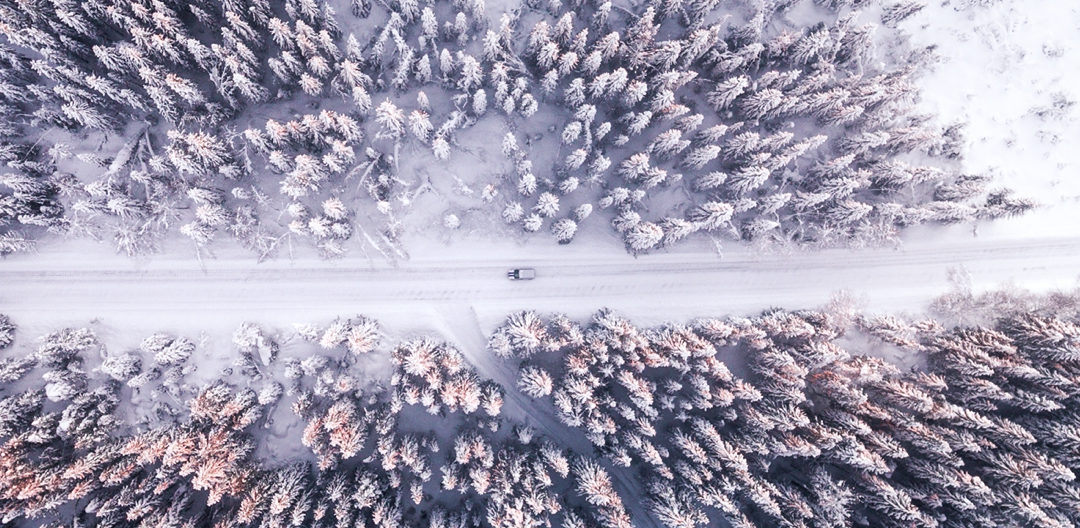Are you driving around mountains or in cold and snowy weather? Adopt the right behavior in order not to leave the road and to control one’s vehicle on snowy roads.
Visibility before anything
First reflex, if your car sleeps outside, is to make sure that visibility is assured. Clear the snow on the headlights optics and rear lights, and clear snow and ice over the entire windscreen, front and rear windows. Do not start driving without making sure that no blind spots are left unchecked. Especially if you are driving at night.
Keep an eye on your wiper blades. They can be frozen and glued to the windshield. Don’t operate them until you have warmed up your windshield (inside heater) as this may damage the rubber of the brush. Check tires, the wear and the pressure.
Smooth drive
In fact, driving on frozen ground, or on snowy roads, is a very good training in eco driving. Indeed, on a slippery surface, the vehicle reacts much faster to any sudden movement, whether in the direction or the speed in which you are turning the driving wheel.
So we recommend going slowly. The start must be done very smoothly, accelerating very very moderately so as not to cause the wheels to skid. If so, lift your foot right away and get going again, gently.
Starting in first or second gear?
You can start in first gear if it is not too snowy or if the road is already clear. On the other hand, if a layer of snow is already present under your wheels, the best option is to start in second gear. Why ? The torque developed by your gearbox makes it possible not to leave the wheels skating if the resistance found on the road is too weak. At worst, your engine will stall and you will not aggravate the situation, by “polishing” the gel or snow under your wheels.
Vehicles equipped with ESP (trajectory corrector) react very well on dry or wet ground, somewhat less well on frozen ground or snow. Our advice: turn off the ESP on snow at start-up and, if possible, prefer a trajectory on fresh snow which have not been made compact yet.
And speed, then?
You have certainly made an educated guess already, we would advise to “stay cool” when it comes to speed. Naturally, you would not normally exceed the speed limit but when facing such weather conditions, it it advised to reduce it by 20 to 30%. And that is where we should really pay attention to the reactions of the car. It is eco-driving in its purest state. The acceleration is only used to get the car going. We accelerate moderately and move gears up without too much delay. Be careful though; our advice is not to get to the last gear (5 or 6th gear) because it is possible that the torque will not be enough to make good use of the engine to brake.
Anticipation
Here, we will adopt one of the great rules of eco-driving, anticipation. Looking out for crossroads, lights, stops, turns far in advance will allow you to adapt your driving early on and allow you to better control your vehicle. If you are a sailor, you will quickly understand that you also have to get ready to make a turn when driving a car on the snow by anticipating. To achieve this, we will have to forget the middle pedal (or left for the cars fitted with automatic gearboxes). The engine brake is the preferred solution for stopping. Use engine brake and shift gears down until the first; then a very soft and delicate pressure on the brakes for the last meters.
Be wary of the ABS
Brutal braking, even at low speed, will activate the ABS system (anti-wheel lock); and this system will not work well. Indeed, it will not find the enough resistance on the road to engage an effective braking. So, consider that you have no ABS and do not push the pedal too hard. Think about having a fresh egg under your foot, and avoid breaking it.
How to handle turns?
A turn must really be anticipated. The foot is lifted before entering the turn, and the engine brake is used. No sudden movement on the steering wheel; the wheels must be able to follow the tracks. A good test is to hold the steering wheel with 2 fingers and feel if the wheels tilt themselves (follow the tracks) or not. If this is not the case, hold the steering wheel firmly and turn gently, without sudden movement.
The risk on snowy roads is that turns can easily make your car veer off course. If you feel the car moving away from the trajectory, do not brake. Lift your foot, go into first gear if it is not already the case and wait for the complete stop. Do not try to straighten the car by turning the steering wheel because you will make the situation worse. Indeed, in this case, many of us are turning the steering wheel far too abruptly and aggravating the situation.
Golden rule: calm and serenity
In the end, everything that will allow you to drive on snowy roads stands in 3 letters: stay ZEN.
ZEN for acceleration, ZEN for stop, ZEN for turns, ZEN for speed.



